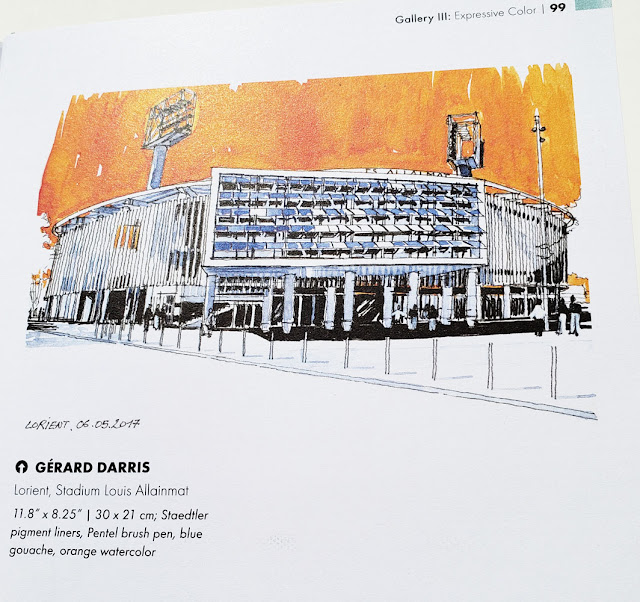 |
| The latest in the Urban Sketching Handbook series |
When I first heard that Montreal painter and urban sketcher
extraordinaire Shari Blaukopf was
authoring Working with Color, I
wondered if there would be much in it for me. Blaukopf is well-known for her
vibrant, luminous cityscapes in watercolor; it would be expected that her book,
the latest in the Urban Sketching Handbook series, would focus on watercolor
painting. It’s been several years since I stopped carrying watercolors in my
sketch kit, and I’ve been loving using colored pencils ever since. Would it be
worth reading? I hesitated for all of five seconds.
Spoiler alert: It’s worth reading. Blaukopf is a master of
color, period. Whatever your chosen medium, her color principles and practices
will apply. You don’t need a degree in color theory to understand these
principles – you just need Blaukopf to explain them simply and
succinctly (with a heavy dose of excellent sketch examples so that you can see
what you are reading). As with the other books in the Handbook series, the
emphasis is on using portable materials in the field. (The book’s subheading is
Techniques for Using Watercolor and Color
Media on the Go.)
The first three sections cover the basics of materials
(including watercolors as well as other media), pigments, color mixing, and
values. Watercolor sketchers will probably especially appreciate seeing her
specific palette choices and recipes for mixing neutrals, darks and a beautiful
range of greens. But even as she reveals her favorites, she encourages sketchers
to experiment and get to know their own palettes well. Thoroughly understanding
how one’s chosen pigments behave and interact is the key to successful color
use.
 |
| Recipes for mixing greens |
 |
| Exciting dark mixes |
 |
| Working with gray scales to learn values |
Even though I’m not using paints, I am still learning from
the color logic behind her choices. For example, I often use Caran d’Ache Museum Aquarelle pencils
in Payne’s gray or Prussian blue for deep shadows because they seem the safest
choices. But seeing her examples of permanent Alizarin crimson mixed with
indigo for a vibrant dark made me think about putting my Prussian blue together
with Alizarin crimson from the Supracolor line for a more interesting shadow mix. I got several other ideas from
those chapters that I will be experimenting with soon.
The sections I am getting the most value from are the ones
on limited color palettes (something I think about often) and color relationships (especially warm/cool and
complements). I’d like to get out of the lazy habit of using grays for shadows,
and these chapters got my wheels spinning on using complements more often for
that job. Just the other day when I was sketching red tulips in a neighborhood traffic circle, I was about to reach
for gray to darken the ones in shadow. But I had just read the chapter on using
complements, so I instead used the same dark green that I had used on foliage
elsewhere in the sketch. Voilà! The flower shadows were both more cohesive and
more vibrant.
I was also inspired and intrigued by examples of sketches
done in a single ink color and the use of spot color with black or gray –
exciting ideas that I am already experimenting with.
 |
| Example of using a single ink color by Brian Gnyp |
 |
| Example of spot color by Nina Johansson |
 |
| How to mix grays without getting mud! |
 |
| Vibrant hues in pastels by William Cordero Hidalgo |
Like other editions in the Urban Sketching Handbook series, Working with Color isn’t intended to be
a comprehensive technical guide (about either color or watercolor). It’s meant
to be a succinct, easy-to-grasp digest of tips that will get you excited about
using color (if you haven’t dabbled in it much yet) or shake you loose from
your lazy color habits (which was my hope for myself in reading the book). It’s
worth a read and a re-read!
(Other
books I’ve reviewed in the
Urban Sketching Handbook series are Architecture & Cityscapes and People & Motion by Gabi Campanario, Understanding Perspective by Stephanie Bower, and Sketch Now,
Think Later by
Mike Daikubara.)


Thanks for a great review!
ReplyDeleteYou're welcome! Glad you found it useful!
DeleteThanks, Tina. Deffo on my list to buy.
ReplyDeleteA fabulous review Tina. I am so appreciative that you took the time to really read and understand it.
ReplyDeleteWith gratitude,
Shari
You're so welcome, Shari! Congrats on a wonderful book!
DeleteGreat review of Shari's book. I didn't buy it yet, but I am planning on it.
ReplyDelete